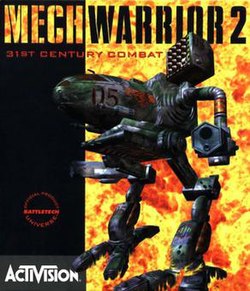MechWarrior 2
| MechWarrior 2: 31st Century Combat | |
|---|---|
 |
|
| Developer(s) | Activision |
| Publisher(s) | Activision |
| Director(s) | John Spinale |
| Producer(s) | Josh Resnick |
| Designer(s) | Sean Vesce |
| Writer(s) | Zachary Norman |
| Composer(s) | Gregory Alper Jeehun Hwang |
| Series | MechWarrior |
| Platform(s) | DOS, Microsoft Windows, Mac OS, PlayStation, Sega Saturn |
| Release date(s) |
DOS July 24, 1995 Windows December 1995 Mac OS July 1996 PlayStation, Saturn March 1997 |
| Genre(s) | Vehicle simulation game |
| Mode(s) | Single player, multiplayer |
MechWarrior 2: 31st Century Combat is a vehicle simulation game developed and released by Activision in 1995, as part of the MechWarrior series of video games in the BattleTech franchise. Originally developed for DOS, it was ported to a variety of platforms including Windows, Apple Macintosh, and the game consoles Sega Saturn and Sony PlayStation (as MechWarrior 2: Arcade Combat Edition).
The DOS, Windows, and Mac releases shared the same gameplay, while the console conversions tweaked the game's mechanics to emphasize arcade-style action over the tactical-simulation of the original PC release. A number of enhanced versions were released to take advantage of the 3D graphics accelerator cards at the time.
MechWarrior 2 features a soundtrack composed by Jeehun Hwang, and a rendered intro sequence by Digital Domain.
At the start of the game, the player must choose to side with one of the two Clans involved in the Refusal War: Clan Wolf or Clan Jade Falcon. The battles in the game take place on planets named in the various BattleTech source books on the war, as well as expanded universe novels such as Bred for War. Each battle has a specific goal such as search-and-destroy, reconnaissance or a base strike. Initially, the player controls one Mech, but in later missions has access to squad commands. Between missions, a mech lab allows players to customize the weapon, armor, engine and heat sinks of any drivable mech.
MechWarrior 2 is played as a tactical simulation, incorporating aspects of both real-time first-person combat and the physical simulation of the player's mech. The player can choose between several control modes, from a basic "point and shoot" mode, to an advanced mode that allows the player to manage the legs and torso of the mech independently. The mech's on-board computer provides feedback to the player, ranging from the proximity of friendly and enemy forces to system damage and ammunition depletion. Among other things, the player must carefully manage heat buildup; the mech's computer will attempt to perform an emergency shutdown if heat levels rise too high, though this can be overridden by the player. However, rising heat levels caused by the repeated firing of weapons can result in ammunition explosions and damage to the mech, including the loss of limbs actuators, and, ultimately, overheating will result in catastrophic detonation of the mech's fusion engine.
...
Wikipedia
